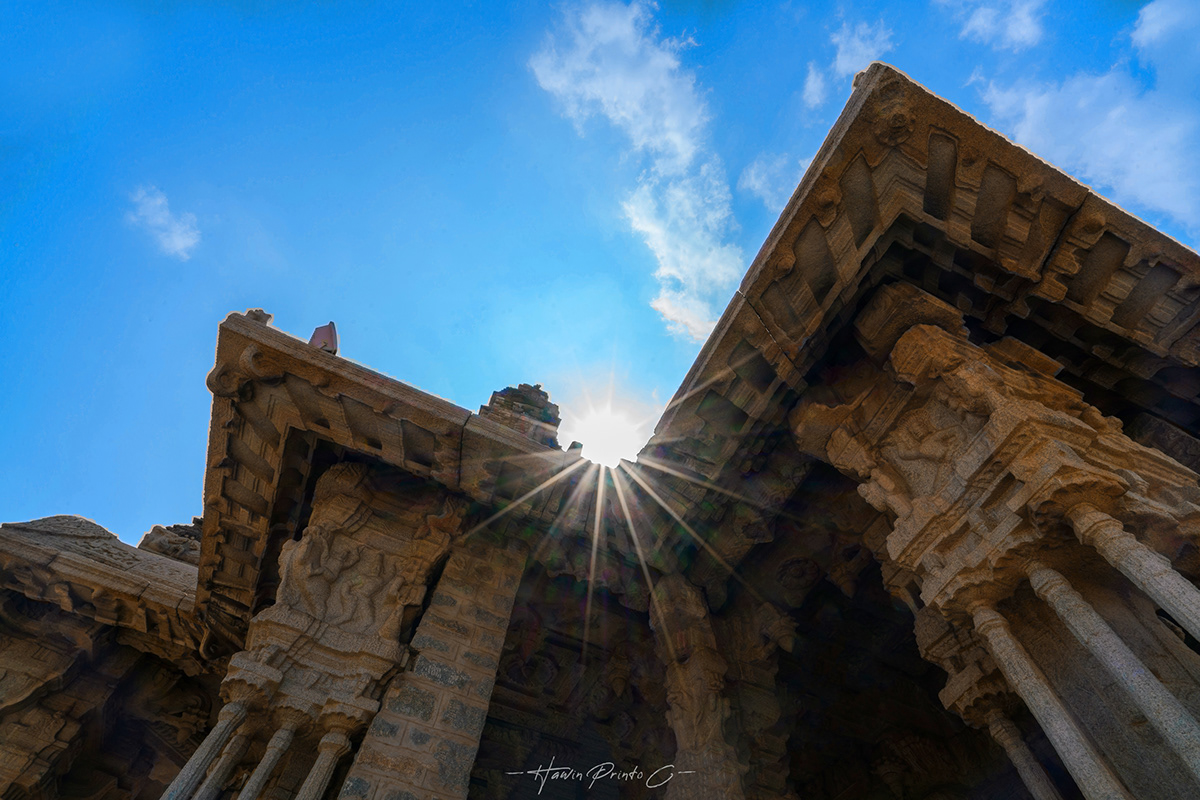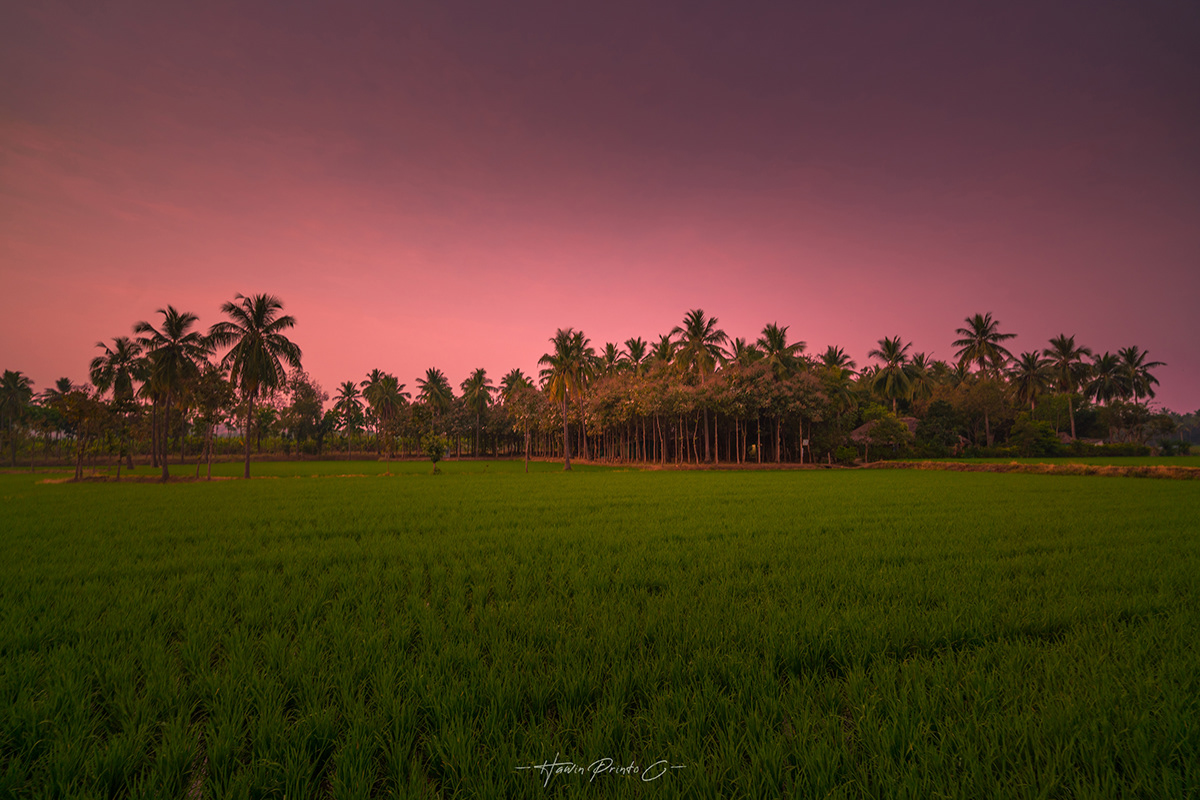[ HAMPI - A UNESCO Heritage Site ]
Hampi, a city embedded in the soil of its glorious past. Most of the city is chiseled from the boulders and earth. But never a stone withers into sand, to bury the old ruins, rather men created it and men destructed it.
[ Ar. Hawin Printo C ]

Once the capital city of the great empire of Vijayanagara and a blooming centre during the reign of King Krishnadevaraya, has now become a scattered reminder of the haunted past. The city enjoys the freedom of having time sublimed into ice and hence has been recognized by UNESCO as one of India’s World Heritage Site.

The open skies welcome a mocking sun and adorned with Stars bright as Bethlehem’s 'Stars of Wonder’. Hampi forms the idea of a woman with the struggles she had to suffer and the blood she washed away. Somewhere between those scattered remains, her heart still reminisces, it beats stronger than ever, to the rhythms her sculptor carved into her. The thumping heart spreads the music through the wind flutes of her musical pillars into every stream and every leaf of the trees bringing life into it. Lean and listen closely as they sing hymns of the gone. Look closely as they wave to the dances of the past, harbored in the fragrance of Plumeria. The journey through the ruins in the heat even opens mirage of oasis in the barren land.






Vishnu brings his presence in Indian history in every Indian state, through the eons and ages. With various names and various purposes, he never exits the theatre of life. The religion Hinduism is entangled with this hermit, whose teaching guide the people to the right way of living. Vittala, was an incarnation of Vishnu, the temple complex and the market stone arches on the way, bring alive the festivities and colors of happiness the place beheld during the reign of the Great King Krishnadevaraya. Vittala temple complex, devoted to the deity, is one of the important sectors of Hampi, where a particular point embarks the setting sun in all shades of orange.



The sacred land has many aspects of the Vedic ages marked upon its surface. The mythology of Ramayana, is engraved on every pillar and stone of Hampi’s boundaries. The magnificent chariot resting upon worshiped grounds of Vittala beholds the shrine of Garuda, the vehicle of Lord Vishnu. Garuda is a mythological creature, which fought Lord Ravan to rescue Sita from abduction. Another significant mark of mythology is the birth place of Hanuman, a devoted warrior of Ram



Entwined with the myths of tradition, the city commemorates the return of Lord Ram, from India’s mythological scriptures of Ramayana. The Virupksha Temple front is lit with diyas of devotees every year during the Dussera festival in the month of October. The diyas are lit around the deity by every devotee forming thousands of patterns like a Mandela. In a similar fashion the Dasara Dibba, was a platform constructed to celebrate the festival during the Vijayanagar Empire. It was constructed to celebrate the victory of the King over Udaygiri.



The city never losses the pure color of soil of birth and Virupaksha Temple, highlights this feature. The centuries old hand works depict skills, unattainable to a seer of the present. When the rays delve through the hole chiseled into the caved walls, the once high and mighty pyramid turns its face upside down in acceptance of the sun. The inverted Gopuram shows the exact calculation and depth of study in architecture in that century. The temple still holds rituals in the worship of Lord Shiva. Many a stones not yet heaved and never to be complete, the temple still stands to the top, a pride of the fallen city. The temple structures prominent during that period is a series of rectangular blocks in concentric form with each rectangular block holding a pyramid structured gateway, which is evident in the main temple block. The various units present to the hills have their own purposes and showcases a change in pattern of construction, probably incomplete, or due to the terrain.








Most of the constructions have the Dravidian architecture style. This style follows the rules of the scriptures of Vastushastra. Almost all the roofing of corridors had the appearance of the tip of a leaf. It is ovate, lobed or toothed. Bringing nature’s components into the composition of a construction help to develop the calmness into the works and the mind. The thick built structure cools the area, a sea breeze amidst the heated surroundings of a day. The walls of granite defended the city in seven lines of enclosure. The enclosurewere Indo-Saracenic in style of architecture, which shows secularism combining the features of both Hindu and Muslim buildings.





In the land of our ancestors, buried by the invaders, a still upstanding archive that shows the skills of the craftsman is the idol of Lord Narasimha made from a single piece of Granite, making it the largest monolith in Hampi. This work also records the reason for the broken Empire. The sculpture originally held a small figure of deity Lakshmi on the lap. This figure and the broken limbs of the idol represent the fall; these signs of mutilation, were to loot the treasure but to the people it was a move from the white bishop to conquer the King by devastating his black rooks. The Hampi Civilization’s belief had anchor upon the Gods, similar to the people of the city of Troy, the destruction of the temples had significance to the loss of the support of Gods to their cause.


The City of Victory, never fails to hold a fight, in the long hilly paths, once waged with war, is still a battleground to those who trod upon it. A day makes our mind pregnant with emotions. To never forget the old days, similar to the battle worn that retires after the sun sets, the safe haven of Hampi is the Hippie Village. The night awaits the sooth tunes of instruments from the wild.









The coracle crosses the river over to the island with the hill tops of peaceful slumber; below the setting sun. The island is calm and lost, with a mystic air filled with music of the travelers. If the morning in Hampi drenches you, the night in the huts of hay, will be the rebirth of your soul in the Neolithic era. A few days here, makes us forget that constant trigger in our minds and bend to the will of solitude. To join in the life of the other side and to remain lingered in those memories of celebration; which makes life worth the struggles.


Elephant's Stable along with their guard room



Lotus Mahal


Queen's Bath



Hampi, is a surviving city, fallen from great heights and yet standing tall to see another era, to be explored by many curious minds, the city of a lost civilization.





